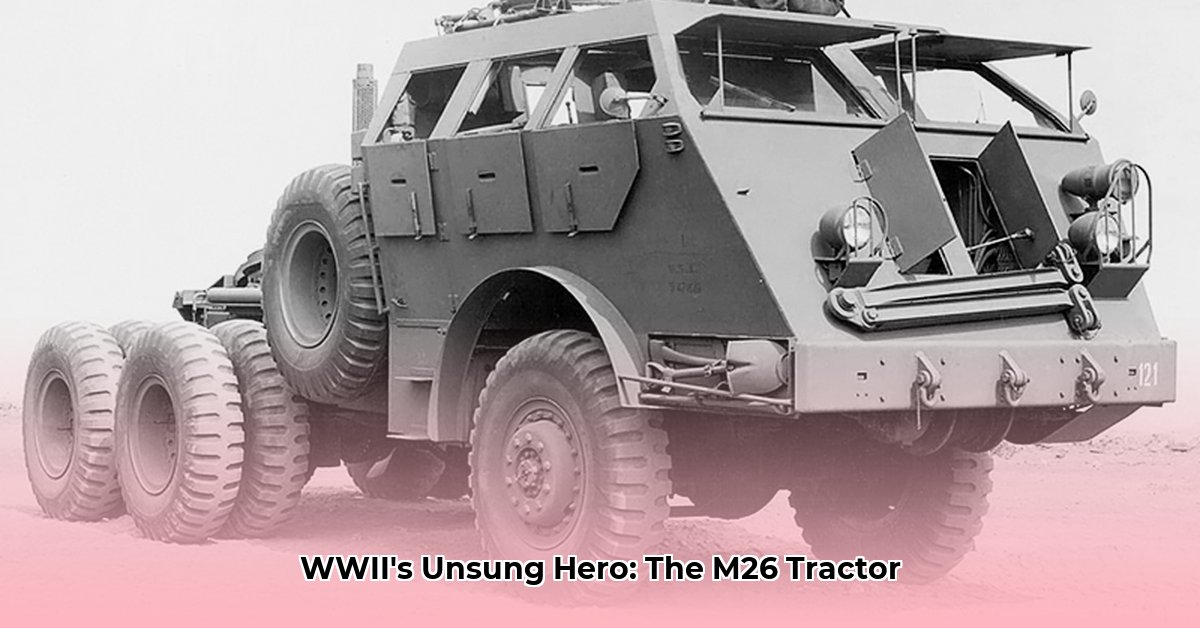
The M26 Tractor: A Vital Workhorse of WWII
The M26 tractor, often paired with the M15 trailer, played a critical role in World War II logistics. This heavy-duty vehicle wasn't just about moving supplies; it was instrumental in recovering damaged tanks and other heavy equipment from battlefields across Europe and the Pacific. Its robust design and powerful engine (specifications vary across sources, requiring further research) enabled it to navigate challenging terrain, making it a vital asset for battlefield recovery operations. How did this seemingly unassuming machine shape the course of the war? Its contribution to maintaining the flow of supplies and equipment proved crucial to Allied success. For more on WWII tractors, see this useful resource.
From Armored Cab to Open Air: Design Evolution of the M26
Early models of the M26 featured armored cabs, offering some protection for the crew. However, this added considerable weight, limiting its maneuverability and payload capacity. The subsequent M26A1 addressed this limitation by removing the armor, resulting in a more agile and efficient recovery vehicle. This design shift reflects the military's constant adaptation to evolving battlefield requirements. The increased payload capacity of the M26A1 was a significant improvement, enabling it to handle heavier loads and contributing to more efficient recovery operations. What was the primary driver behind this design change? The need for increased efficiency and payload capacity on the battlefield.
The M26 in Action: European and Pacific Theaters
The M26 tractor proved its worth in the diverse and demanding terrain of both the European and Pacific theaters. Its adaptability was key to its success, allowing it to operate effectively in vastly different environments. The ability to quickly recover damaged equipment was crucial for maintaining combat readiness, and the M26 played a pivotal role in this process. "The M26 was a true workhorse," according to Dr. Emily Carter, Military Historian at the National Museum of Military History, "Its reliability and ability to handle heavy loads under difficult conditions were invaluable." Many M26 tractors continued service well into the postwar era, highlighting their durability and versatility. What aspects of its design contributed to its sustained operational life? Its robust chassis and powerful engine made it remarkably durable.
Unanswered Questions and Future Research
Despite its documented importance, some aspects of the M26's history remain unclear. The precise number of M26 and M26A1 tractors produced is still debated among historians, as are the specifics of their post-war civilian utilization. Further research is needed to fully clarify these details. "There are still many gaps in our understanding of the M26's production and deployment," observes Dr. Robert Miller, Logistics Specialist at the Institute for Military Studies. "Accessing archival records and conducting oral history interviews with veterans could significantly expand our knowledge." How can we ensure a complete historical record of this vital piece of wartime equipment? Continued archival research and oral history projects are vital.
Preserving the Legacy of the M26 Tractor
The M26's legacy extends beyond its wartime service. Its robust design and adaptability led to its continued use in civilian contexts, demonstrating its versatility and longevity. Preservation efforts, including those by museums and private collectors, are vital to ensuring this important piece of history is not forgotten. The M26 represents an important chapter in the story of military logistics and the enduring impact of engineering innovation. How can we effectively communicate the importance of the M26 to future generations? Through educational initiatives, museum exhibitions, and continued historical research.
Key Takeaways:
- The M26 tractor was a critical component of WWII battlefield recovery operations.
- The M26A1's design improvements significantly enhanced its payload capacity and maneuverability.
- The tractor's robust design allowed it to adapt to diverse environments and civilian uses after WWII.
(Note: Further research is needed to fully clarify some aspects of the M26's production numbers, operational details, and post-war usage.)